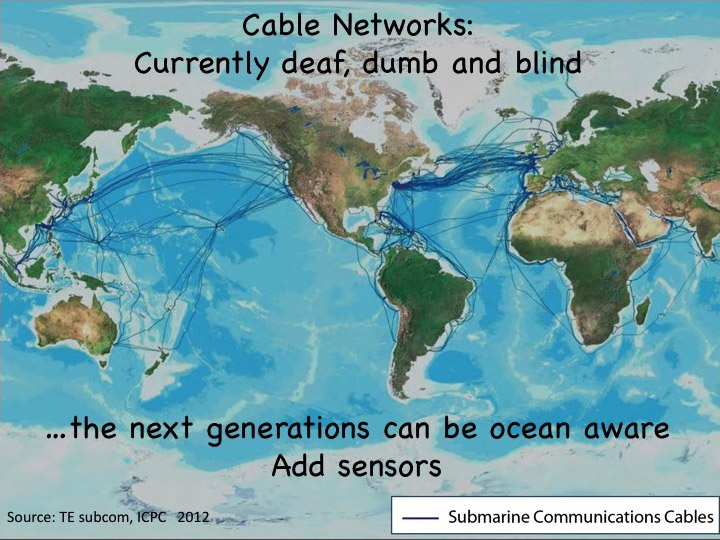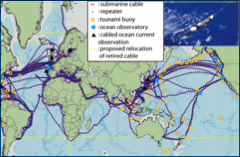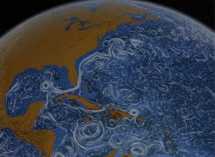Report on two NASA Workshops
From space to the deep seafloor:
Using SMART submarine cable systems in
the ocean observing system
9–10 October 2014
Keck Center, California Institute of Technology (CalTech)
Pasadena, California USA
26–28 May 2015
East-West Center, University of Hawai‘i at Mānoa
Honolulu, Hawaii USA
7 September 2015
Bruce Howe and Workshop Participants

SMART: Science Monitoring And Reliable Telecommunications
Climate Monitoring and Disaster Mitigation
Context
The ITU/WMO/UNESCO IOC Joint Task Force (JTF) was established in 2012 to investigate the use of submarine telecommunications cables for ocean and climate monitoring and disaster warning. These workshops reported on herein were an outgrowth of the JTF effort, the first in-depth scientific meetings to consider the topic.
Acknowledgments
Recognizing the potential connections between widespread cable-based measurements and space-based satellite measurements, NASA awarded grant NNX14AO89G to the University of Hawai‘i at Mānoa, principal investigator Bruce Howe, to conduct and report on the workshops. The support and guidance of NASA program manager Eric Lindstrom is much appreciated. This report is a collective effort of all participants.
Web page
The web page www.soest.hawaii.edu/NASA_SMART_Cables reproduces the executive summary and provides links to the workshop report, summary presentation, and presentations by individual participants (collected into one file):
- NASA SMART Cables Workshop Report 2015 (PDF)
- NASA SMART Cables Workshop Summary Presentation 2015 (PDF)
- NASA SMART Cables Workshop Participant Presentations 2015 (195 MB PDF)
- NASA SMART Cables Workshop Poster AGU Fall Meeting 2015 (PDF)
- NASA SMART Cables Workshop Poster Ocean Sciences Meeting 2016 (PDF)
Citation
This report should be cited as:
Howe, B. M., and Workshop Participants (2015), From space to the deep seafloor: Using SMART submarine cable systems in the ocean observing system, Report of NASA Workshops, 9–10 October 2014, Pasadena, CA, and 26–28 May 2015, Honolulu, HI. SOEST Contribution 9549,
www.soest.hawaii.edu/NASA_SMART_Cables/NASA_SMART_Cables_Workshop_Report_2015.pdf
Executive Summary
Planning is underway to integrate ocean sensors into SMART subsea cable systems providing basin and, ultimately, global array coverage within the next decade (SMART: Scientific Monitoring And Reliable Telecommunications). In this report on two NASA-sponsored workshops, we explore the scientific benefits of the associated measurements in the ocean observing system linking with satellite and other ocean observations.
SMART cables will:
- Contribute to the understanding of ocean dynamics and climate.
- Improve knowledge of earthquakes and forecasting of tsunamis.
- Complement and enhance existing satellite and in-situ observing systems.
SMART cables will be a first order addition to the ocean observing system with unique contributions that will strengthen and complement satellite and in situ systems.
Cables spanning the ocean basins with repeaters every ~65 km will host sensors/mini-observatories, providing power and real-time communications. The current global infrastructure of commercial submarine telecommunications cable systems consists of 1.5 Gm of cable (1 gigameter, 1 million kilometers, 40 times around the earth) with ~23,000 repeaters (to boost optical signals); the overall system is refreshed and expanded on time scales less than 10 years and individual systems have lifetimes in excess of 25 years. Initial instrumentation of the cables with bottom temperature, pressure, and acceleration sensors will provide unique information for monitoring and studying climate change and improved tsunami and earthquake warning. These systems will be a new highly reliable, long-lived component of the ocean observing system that will complement satellite, float, and other in situ platforms and measurements.
The addition of SMART sensors leverages $40M onto the $250M base cost of a present day trans-Pacific 10,000 km cable system with 152 repeaters. Ten such systems cost about $400M, about the same as for a five-year satellite mission, but the cables will last 25 years. If two systems per year are deployed in this time frame, 7,600 SMART sensors will be operating on the seafloor.
Several UN agencies have come together to facilitate this incorporation of science sensors for climate and ocean observing and disaster mitigation into commercial submarine telecommunications cable systems. The International Telecommunication Union, the World Meteorological Organization, and the UNESCO Intergovernmental Oceanographic Commission have formed the Joint Task Force to move this concept to fruition (ITU/WMO/IOC JTF; www.itu.int/en/ITU-T/climatechange/task-force-sc).
SMART cable measurements will be relevant to the understanding of climate and its variability. They will greatly improve our knowledge of deep-ocean variability (e.g., temperature) and impose constraints on important depth-integrated quantities (e.g., pressure, and in subsequent phases, depth averaged heat content and velocity), all with high frequency temporal and spatial sampling on a global scale for the first time.
Specific ocean measurements enabled by SMART subsea cables using the initial sensor suite include: spatial and temporal variability of deep-ocean temperatures; propagation of heat anomalies through ocean basins and along ocean boundaries; temporal variability of barotropic tides that impact tidal corrections for satellite missions; ocean response to atmospheric pressure forcing on fast (hours to days) time scales; and impact of infragravity waves on high-precision altimetry and gravity missions.
With subsequent sensors, additional measurements are possible. Active and passive acoustics and cable voltages can provide depth averaged temperature (heat content) and along cable and cross cable depth averaged velocity, transports of heat and mass, and internal wave and tide variability. The simultaneous determination of mass loading and earthquake hazard response effects can be used to evaluate satellite altimetry and gravity missions. Robust bio-optical sensors can characterize carbon export to the seafloor; conductivity for salinity can better determine bottom density and water mass. Passive hydrophones can measure wind, rain, ultragravity waves, marine mammals, and shipping, and can also serve as receivers in an acoustic thermometry network.
The initial sensor suite will improve tsunami and earthquake early warning systems. The acceleration data will speed up the determination of earthquake source parameters, now poorly constrained, that are used as input for tsunami propagation models and earthquake hazard response. The bottom pressure will constrain tsunami amplitudes much faster than the sparse DART array (latencies of seconds vs. ~hour, respectively); further, pressure measurements allow detection of tsunamis that are not caused by large earthquakes, e.g., landslide generated tsunamis.
SMART cable systems can make unique and complementary contributions to the existing earth observing systems and provide synergies with satellite observations.
- SMART sensors provide an orthogonal space/time coverage with respect to other observing system components with data from ~20,000 nodes along ocean basin spanning paths that resolve mesoscales (~50 km) with high frequency (seconds to minutes) sampling. Temporal aliasing will be effectively eliminated compared to satellite and other in situ systems.
- Sea level, globally remotely sensed with satellite altimetry, depends on in situ measurements (e.g., SMART pressure and temperature) for validation, and tide and other high frequency (e.g., infragravity waves) corrections.
- Gravity, globally measured by GRACE on ~1000 km scales, can be interpreted as ocean bottom pressure (in equivalent cm of water); the SMART pressure measurements serve as ground truth and de-aliasing for tidal and other high frequencies. SMART pressure data are necessary for ground truth validation of GRACE data, leading to significantly improved precision and global resolution.
- The SMART pressure sensors can detect surface (infragravity) waves useful for correcting future satellite altimetry missions and improving wave models.
- While deterministic astronomical forcing generates the ocean tides, the tides are now known to vary on seasonal to centennial time scales due to changes in the ocean state—currents, stratification, water column thickness, ice cover, etc. SMART measurements are uniquely suited to constrain time evolving tide models needed to correct satellite products.
- Ocean surface wind stress produces large spatial scale barotropic (top-to-bottom) currents with time scales of 10 days (storm) or less, affecting satellite altimetry and gravity results. Presently atmospheric weather models are used to correct the satellite measurements but SMART measurements have the capability to estimate the wind stress through an inverse process (a research problem).
- Within a few years of deployment, SMART seafloor temperature sensors will be able to determine climatically significant trends (~5 mK/y) with high temporal and spatial sampling, growing to 20,000 nodes with 50 km spacing, compared to a projected 1,000 deep global ARGO floats.
- Next-generation acoustically determined along-cable velocity and temperature, combined with cable voltage measurements providing cross-cable absolute transport, could improve estimates of ocean mass and heat transports, greatly improving our knowledge of full-depth ocean circulation.
- Ocean modeling can be used to estimate the impact of SMART cable bottom pressure measurements on ocean state estimation, and then assimilate the SMART data. High-resolution simulations and existing data can characterize the high-frequency variability of the SMART cable bottom pressure and temperature measurements.
Recommendations and outstanding questions from the two workshops include the following.
- The SMART cable concept deserves broad support from the scientific community, with support from government sponsors.
- The seismic and tsunami communities should clarify their strong scientific case for SMART cables through similar workshops.
- The scientific community should prioritize which cable routes are most useful for this purpose.
- The scientific and subsea telecommunications industrial communities should assist the JTF to identify a SMART demonstrator cable system.
- Continue work to extract bottom pressure from high resolution global ocean models to quantify expected seasonal (and longer) variability of tides that SMART cables would be uniquely capable of measuring, with impacts on altimetry and gravity.
- Perform sensitivity experiments that elucidate the degree to which assimilation ocean models are sensitive to SMART cable measurements (e.g., in the form of volume of water colder than 1.5°C).
- Perform Observation System Simulation Experiments (OSSEs) for the proposed sensors to quantify ocean state estimate improvements. This will, for instance, provide strong constraints on otherwise unconstrained deep temperature.
- Build on the sensitivity experiments and OSSEs to develop a “SMART cable mission simulator” that produces realistic data and noise from models, performs data assimilation, compares with truth, estimates uncertainties, and produces useful products. Data would include measurements from the initial pressure and temperature as well as, for instance, cable voltage and inverted echosounders.
- Perform simulations to quantify the improvement in accuracy and speed for tsunami (bottom pressure) and earthquake (accelerometer) warning systems using SMART cable measurements, similar to the ocean observing simulations.
- Begin development of sensors for following phases, e.g., acoustics and cable voltage, bio-optics and biogeochemical sensors.
- In many cases, cables are buried in shallow water to protect them from external aggression (e.g., fishing and anchoring; <1000 m). What are the ramifications for the temperature and pressure measurements?

|

|
(far left) Map showing existing submarine telecommunications cables with repeaters schematically highlighted; a repeater is shown (top right). (near left) Sample output of a high resolution ocean model. |
[ Top of Page ]
